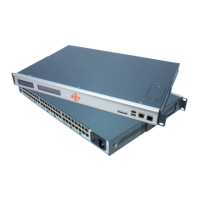13: Maintenance
SLC™ 8000 Advanced Console Manager User Guide 289
To resolve a host name into an IP address:
diag lookup <Hostname> [email <Email Address>]
You can optionally email the displayed information.
To test a device port by transmitting data out the port and verifying that it is received
correctly:
diag loopback <Device Port Number or Name>[<parameters>]
Parameters
test <internal|external>
xferdatasize <Size In Kbytes to Transfer>
Default is 1 Kbyte.
Note: A special loopback cable comes with the SLC unit. To test a device port, plug the
cable into the device port and run this command. The command sends the specified
Kbytes to the device port and reports success or failure. The test is performed at 9600
baud. Only an external test requires a loopback cable. The External test is currently not
supported for USB device ports.
To display the route that packets take to get to a network host:
diag traceroute <IP Address or Hostname>
To verify that a host is up and running:
diag ping|ping6 <IP Address or Name> [<parameters>]
Parameters
ethport <1|2> count <Number of Times to Ping>
The default is 5.
packetsize <Size in Bytes>
The default is 64.
To display performance statistics for an Ethernet port or a device port (averaged over the
last 5 seconds):
diag perfstat [ethport <1|2>] [deviceport <Device Port # or Name>]
To generate and send Ethernet packets:
diag sendpacket host <IP Address or Name> port <TCP or UDP Port Number>
[string <Packet String>] [protocol <tcp|udp>] [count <Number of
Packets>]
The default protocol is tcp and the default count is 1.
To display all network traffic, applying optional filters:
Note: This command is not available on the web interface.

